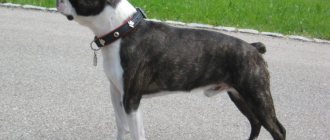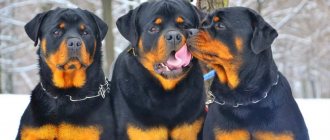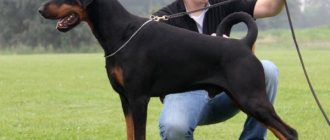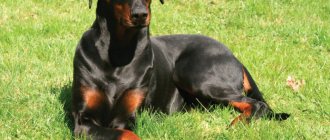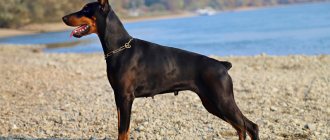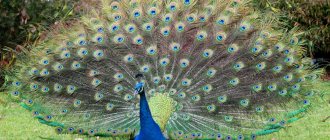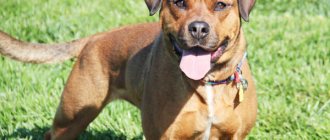In many countries around the world, docking is considered an atrocity and is prohibited, but Russia has not yet signed a convention to abolish obligations on cropping ears and tails of show breeds.
The Rottweiler is one of the dogs whose standard has traditionally required docking.
The rule no longer applies, but in Russia this procedure has many supporters. Therefore, this issue is still relevant for dog breeders. However, before you decide to have surgery, you should weigh the pros and cons.
Are there any indications?
Dogs of this breed were almost always tailless. Puppies had their spinal appendage cut off in the first days of life, and this was done for several reasons:
- Rottweilers took part in dog fights.
- Dogs drove cattle and protected them from predators.
- From an early age, the puppy was made into a guardian of the home and family.
In all these cases, the long tail got in the way of the dog and made it vulnerable. The predator could grab onto it and disorient the dog, causing him serious damage at this time. Another argument of docking advocates is that without a tail, the Rottweiler looks more aggressive.
Some breeders believe that the spinal appendage is a hindrance for this breed. Rottweilers have been docked for centuries, so there is an opinion that nature has inherent in them the characteristics of a tailless existence. Dogs move, express emotions, and show aggression differently than animals that have not undergone surgery.
There are not many medical indications for docking Rottweilers. Basically, these are injuries that are incompatible with normal life activities. A dog without a tail can participate in exhibitions, since this option is prescribed in the breed standards, however, at international competitions, judges can find fault with such a dog.
Character
Why do Rottweilers have their tail docked? In earlier times, representatives of the breed performed a number of functions. This included not only guarding and shepherding skills. Unfortunately, these dogs did not escape the fate of the fighting.
And so that the dog was least vulnerable, its tail was docked. Now, according to many breeders and owners, this is completely unnecessary. The Rottweiler with a tail is supposedly more intelligent than its tailless counterpart. The idea that the presence of intelligence depends on the length of the tail seems strange.
Okay, we digress. Let's talk about the dog's character.
Do you have a Rottweiler puppy in your home? This is great, the breed is wonderful. If you raise a dog correctly, you will get a faithful friend. Have you ever owned large dogs and don’t know how to raise them? No problem, seek help from a professional dog handler.
In general, the Rottweiler is a dog that needs to be raised under competent supervision. Because it is impossible to make mistakes in its upbringing, due to the nature of the breed, then these mistakes are almost impossible to correct.
The main advantages of Rottweilers:
- Devotion to the owner.
- Affectionate attitude towards your own people.
- Well developed security qualities.
- Smartness.
- Curiosity.
- Physical endurance.
- Easy adaptability to different conditions.
- Courage.
Representatives of the breed are very smart. They quickly figure out how to act. And if the owner seems too soft to the dog, the pet will immediately sit on his neck.
Animals are wary of strangers. With proper training, these dogs are able to tolerate the presence of a stranger on their territory. If he does not show excessive activity, trying to make friends with the guard dog. If something happens, a representative of the breed is able to put a stranger in his place.
There is an opinion that a Rottweiler with a tail (as well as without a tail) is an excellent nanny. This is wrong. If a dog is patient with children, this does not mean that he is eager to be a nanny. You should not allow a child to bother your pet, much less treat it roughly.
Care after cupping
A docked ponytail requires almost no maintenance. It is enough to change the antiseptic bandage once every 3 days until complete healing. But the healing process of the ears needs to be carefully monitored.
After the operation, the cut edge is treated daily with a solution of brilliant green. If the puppy tries to scratch its ears, it is better to wear a protective Elizabethan collar. Any scabs that appear must be softened with peroxide and removed with a cotton swab.
After complete healing, a bandage is applied to the ears after 5–7 days. It is made from available materials: foam rubber, adhesive plaster and bandage. Foam rollers are placed inside the ears, an adhesive plaster is wrapped on top of the shell and secured in a standing position with a bandage.
Important! If an inflammatory process occurs, it is important to contact a veterinarian.
Breed standard
The photo shows a Rottweiler with a tail. According to the breed standard of 2000, it was then that amendments were made to allow the dog to have a long tail.
Let's talk about the breed standard in order:
- The Rottweiler is a large, muscular dog. The minimum weight for a male dog is 47 kilograms. The bitch's weight starts at 42 kilograms.
- Male height varies from 61 to 68 centimeters. Females are smaller - from 55 to 63 centimeters.
- The dog's head is of medium length. The transition from forehead to muzzle is clearly pronounced.
- The eyes are medium-sized, almond-shaped.
- Large nose.
- Lips are dry, tightly compressed.
- The jaws are powerful and wide.
- The neck is dry, moderately long, and muscular.
- The back is straight.
- The chest is very deep.
- Limbs are straight and muscular.
- There are Rottweilers with and without a tail.
- Color black with dark brown or red tan.
What are the differences between boys and girls?
There are big differences between males and females in this breed.
Perhaps the most important difference is the size and weight. Males are larger and larger, females are smaller and more compact. This difference is easy to determine by eye.
Males are more aggressive than females and are stubborn . Therefore, males are suitable for experienced dog owners, and females are suitable for beginners, because they are more flexible.
But this does not mean that the future owner does not need leadership qualities. In any case, bitches become more attached to a person and learn better.
CAREFULLY!
The disadvantages of females include the period of estrus, and males tend to run after females during this period.
The owner of the bitch will also have to deal with the animal's pregnancy and childbirth.
Possible complications
The most common problem after cupping is scarring. Unsightly healed edges of the ears or tail make the dog less attractive.
When using non-sterile devices, blood poisoning and the appearance of an abscess at the incision site may occur. Any inflammation is a bait for infections, because local immunity is sharply weakened.
Interesting! It is believed that an animal with a docked tail is less sensitive and more aggressive. The dog cannot show emotions like other dogs, so it has poor contact with others.
Main color
The main color of the Rottweiler is black. His name is tan.
Tan spots have clearly defined boundaries and are found in certain places:
- On the head in the area of the cheeks and eyebrows.
- Under the larynx.
- In the chest area.
- On shoulders.
- On the inner thighs.
- In the anal area.
- At the bottom of the legs.
Proper ear care for growing young German Shepherds
In order for a dog to meet breed standards, it is necessary to take care of the baby’s health and the proper formation of ear cartilage from a young age, following simple measures:
- up to 6 months, it is not recommended to stroke a German Shepherd puppy on the head and allow fights with other dogs to avoid deformation of the soft ear cartilage;
- When your pet is sleeping, you must ensure that the puppy does not press its head against the wall;
- to prevent the development of otitis media, it is recommended to regularly clean the ears of growing young animals;
- It is necessary to provide the puppy’s body with a sufficient amount of calcium from birth; for this, you can introduce cottage cheese, yogurt, kefir, bone meal or special mineral supplements into the little friend’s diet after consultation with a veterinarian;
- Do not stop giving mineral supplements if your ears become erect early. At the age of 3-5 months, puppies undergo a change of teeth, against the background of which the ears may fall if there is insufficient amount of calcium in the dog’s body;
- it is recommended to stimulate the work of the ear muscles for the natural erection of the ears; for this, in the presence of the puppy, it is necessary to make various new sounds that encourage the dog to raise his ears;
- chewing muscle movements also strengthen the ear muscles, so it is recommended that you let your puppy chew on safe toys and cartilage treats.
German Shepherd ears are cropped only in exceptional cases.
Feeding
Above we mentioned super-premium food. You can buy special food made taking into account the characteristics of the breed. Or you can simply choose universal food. It must be of high quality - this is the path to a healthy dog.
A good super-premium food (holistic) costs about 6,000 rubles. Quite an impressive amount for a bag that will last for a month. But if you calculate how much money will be spent on natural products, then it is cheaper to buy high-quality food. At least it's completely balanced.
Have you decided to feed “natural”? We list here the necessary products:
- Lean meat: veal, turkey, beef. Chicken can cause allergies; its introduction into the diet should be approached carefully.
- Vegetables are a side dish for meat.
- The main grains given to dogs are rice and oatmeal.
- Sea fish is lean, boneless.
- Dairy products: cottage cheese, kefir, cheese.
- Boiled eggs.
- Fruits: apples, unsweetened pears.
- Offal.
- Crackers made from black and wheat bread as a delicacy.
An adult pet is fed twice a day. In the morning and in the evening.
Representatives of the breed are prone to obesity. Be careful not to overfeed your dog. His ribs should be palpable. If, by placing his hand on the dog’s ribs, the owner discovers a thick layer of fat, it’s time to reconsider his diet. And make adjustments to the single portion, reducing it.
Care
The breed is not known for its longevity - the average life expectancy is 8-10 years. The final figure depends on the conditions under which the dog is kept. To keep your molosser healthy, follow these simple steps:
Bathing. It is not advisable to perform water procedures with detergents more than 2 times a year. Frequent washing removes the protective fat layer.
Combing. Apply with a stiff brush or comb twice a week. During molting, scratch 3-4 times.
Ear cleaning. This is done weekly using cotton pads soaked in hydrogen peroxide.
Trimming claws. Manicure is done up to 4 times a month, being careful not to touch living tissue with scissors.
Note!
- Airedale Terrier: description of the breed, tips for choosing puppies and breed standards (video + 85 photos)
Bernese Mountain Dog - description, breed standard, price, features of care and cultivation (105 photos and videos)
Jack Russell - characteristics of the breed, character, care, maintenance and training of a particularly active dog (125 photos)
Dental hygiene. To remove tartar and form a scissor bite, it is necessary to allow the dog to gnaw on large bones.
Eye examination. Mucous secretions are blotted with a dry swab or damp cloth. If there is excessive tearing, you should contact your veterinarian.
The best Rottweilers who have crossed the two-year mark are selected for mating. The offspring are carried for 9 weeks.
Stages of the procedure
When performing an operation without anesthesia, it is better for the owner to hold the pet with his hands so that he does not escape, and the veterinarian carries out all the manipulations without errors. The procedure follows the following scheme:
- The tail is tightly tied with a strip of bandage closer to the base. This makes blood circulation in the appendage more difficult.
- An antiseptic is used.
- They feel the tail with their hands to mark the cutting line - it runs between two adjacent vertebrae.
- Using a scalpel or strong scissors, cut the tail along the intended line.
- Treat the wound with an antiseptic. If necessary, stitches are applied (small puppies do not need them).
- The bandage strip is removed half an hour after the operation.
The whole process lasts no more than 5 minutes. You can call a veterinarian to your home and carry out the procedure in more comfortable conditions for the dog, especially if it has already grown up. The operation scheme is no different from the clinic conditions.
It is not recommended to dock the tail yourself, since only a person with a veterinary education will do everything correctly. If the cut line is inaccurate, the dog will have a flaw for life; no corrections are provided. It is even possible to be disqualified from competitions and prohibited from mating.
Contraindications
The procedure cannot be performed if the puppy has abnormalities in growth and development. The operation is prohibited if the dog is sick, since a weakened immune system cannot cope with the increased load. It is advisable to postpone docking to a later date if the pet behaves strangely for no apparent reason - eats little, shows apathy or aggression.
How to properly dock a Rottweiler's tail
Docking (trimming) the tail and ears in the first days of a puppy's life was a common practice for fighting dog breeds, which includes the Rottweiler. In a fierce fight with an opponent, a dog with a long tail and ears can be seriously injured. Today, when fearsome fighting dogs have become companions and pets, there is no need for Rottweiler tail docking. In many European countries this action is prohibited. In Russia, this issue is left to the discretion of the owner. According to the breed standard, both Rottweilers with and without a tail are allowed for exhibitions.
It is important
We found out what kind of tail a Rottweiler has and why it is docked. Now let's touch on the most frightening character trait.
Other individuals are very aggressive. But not being able to throw off this aggression, the dog accumulates it within itself. And he goes crazy. Literally. The animal becomes simply uncontrollable and is capable of attacking its owner.
To avoid this situation, exercise your dog regularly. Give her both physical and mental stress.
When will the Rottweiler's tail be legalized?
Quote: Message from Tamara…………..That’s cool!!! It wouldn’t hurt to first study the anatomy and physiology of a dog before writing such angry and absurd “libel”. First, you need to study anatomy and physiology...before you sit and write. They have mutilated the breed and continue to mutilate it!!! Some out of “humanity”, although humanity is somehow hypocritical, others worshiping Western trends! The Rottweiler was originally bred with a docked tail standard. But what about docking of dewclaws, like castration... or other surgical interventions... we do not have the right to decide for a dog whether to undergo surgery or not. The widespread leaving of tails on Rottweilers leads to a distortion of the appearance of the breed and will ultimately require a change in the breed standard. Rottweilers lose their power and strong jumping ability. In countries where tail docking has long been prohibited, Rottweiler breeders began to note that if a Rottweiler has a tail, the muscularity of the croup changes, from wide and powerful to narrow and flat. Anyone who is even approximately familiar with the history of the breed knows that the Rottweiler has been a dog without a tail since time immemorial. The short tail was a distinctive feature; the short tail, emphasizing the individuality of the breed's style and giving the Rottweiler a unique charm, can be called symbolic. The Rottweiler is a working service dog that should be powerful and maintain its working qualities, and not a lap accessory. Veterinary aspect: Considering the problem of humanism from the perspective of veterinary medicine, I would like to express the opinion of many, many dog breeders. Since the influence on such prohibitions comes from the West, it is appropriate to ask: what about the widespread practice of castration of males and sterilization of females there? After all, in fact, this is monstrously inhumane, even cynical in some ways, but it is convenient for human society, and therefore does not raise questions. It seems that this is where the rights of an animal to have a full-fledged organism are blatantly violated. In my opinion, dewclaws are justifiably docked. Maybe it’s worth leaving them in the interests of humanity? Let the dog injure them on the crust and sedge, but our conscience will be fine... What about other operations that cause much more pain and suffering than tail docking at three days of age? Perhaps the time has come to consider their feasibility in the light of humanism? After all, these operations are performed by a person without asking the dog’s permission, and in natural conditions the animal either recovers on its own, without emergency intervention, or dies. So why is it possible to save an individual animal using techniques that are very painful for him, but doom an entire breed to extinction by freeing dogs from a little pain in puppyhood? In addition, some older breeders use a painless and bloodless method of tail docking. Anatomical aspect: For hundreds of years, the Rottweiler has been bred as a multi-functional dog breed with a docked tail. Although not a high-speed dog, the Rottweiler still has very productive movements and good dynamic characteristics. He has confident movements, stable gaits, and a powerful throw. If you compare the movements of a Rottweiler, Doberman, Boxer, for example, with a German Shepherd, Labrador and other “tailed” dogs, you can notice their special type, developed over the years. Tailless dogs are deprived of the ability to “rule” and balance their tail and do this through a specific rearrangement of muscles that has developed over generations. At a gallop, these dogs resemble a swift core; at a trot, they are distinguished by a monolithic, muscular, straight profile top. But the set and shape of the tail, if left, can be anything. The animal will have to adapt its body to movement in new conditions, from which this body has become “unaccustomed” over many centuries. Selection aspect: Experts know that puppies are born with different tails - long, short, with one kink and many congenital kinks, etc. Moreover, the relationship is known: the shorter and wider the head, the sooner we should expect kinks and short tails. Adult Rottweilers have even more interesting tails: their tails can be sickle or ring, lowered or set vertically, smooth and feathered. But you never know what else can be observed, because no one has ever carried out a selection on this basis; there were enough other worries. Just imagine that a lot of animals, excellent in all other respects, were culled. How much has the breeding population narrowed? And what individuals that do not meet the fundamental requirements for a Rottweiler, but with the correct tail, will “get through” into breeding to secure the correct tail shape! Step back? No, jump! But, you say, let’s select in stages, let’s allow for several variations of the tails. And the once majestic rings of magnificent, selected exhibition Rottweilers will begin to resemble a pack of different-tailed mongrels... The effect is the same - a decrease in the popularity of the breed and interest in it. Practical aspect: The most banal, but significant for any Russian citizen. The short tail of a large dog makes it easier to keep. It's no secret that in our small-sized apartments the issue of saving space is very acute. Probably, our Western colleagues will not understand us, but where can you go... In our narrow corridors, “tailed dogs” smash their tails on the sharp corners of the furniture until they bleed, painfully whip the legs of the guests and hosts they meet, and knock down small children. In addition, it is easy to step on the tail in the dark; the dog carries a lot of dirt on it in rainy weather. It is no coincidence that many people who have chosen the Rottweiler out of all breeds cite the absence of a tail as one of the arguments in favor of choosing the breed. And if you look at how things stand in practice in countries where this ban has already been implemented? Breeders and owners of those breeds affected by the veto travel to countries “free” from this ban, issue litters there or register dogs. Need I say that only the most serious dog breeders go to such difficulties, advocating for the standard, familiar appearance of their dogs? Why create additional problems for those who selflessly work for the benefit and prosperity of their breed? — — — Added — — — Quote: Message from Rottwesthouse There are trolls on the Internet with flayer tendencies Come on23 You’re being a hypocrite... if your dog gets sick and requires surgery, don’t operate on this same knackering...Rotsaler, Now is the time that every teapot wants to leave a significant mark in history. And they began to introduce their own standards, disfiguring the breed; the Rottweiler standard was and should remain without a tail. I still have manuals on dog breeding and the current standards were then considered vices. — — — Added — — — Quote: Message from n_velichutin I read the topic with the “killer” argumentation of opponents of the tail. There are no more problems than to be or not to be a tail. It’s only people with dislocated brains who put holes in their cheeks, drill holes in their heads, make holes all over their bodies and insert all sorts of metal trinkets into them. If some people are interested in this, then let them experiment on themselves, but what about dogs? Personally, a Rottweiler’s tail doesn’t bother me at all. The tail is a good indicator of a dog's mood. I’m wondering, if you’re a girl, it’s not clear from your nickname who you are... have you pierced your ears? As for the tail of the roti, if you know the dog’s mood by the tail, then you are a bad owner, the dog’s mood is clearly visible even without a tail!
Tail docking for a Rottweiler
Veterinarians' opinions
Dinara, 34 years old, Ryazan
“I think Rottweilers should definitely have their tail docked. It makes them look like non-pedigreed dogs, like an ordinary mongrel. For some reason, people think that they should leave what is given by nature. Only Rottweilers were bred artificially - what kind of nature are we talking about?”
Pavel, 38 years old, Samara
“I recently saw a long-tailed Rottweiler. Unusual, but interesting. I think that the owner himself should decide whether to dock the tail or not. Everyone has their own beliefs on this matter.”
